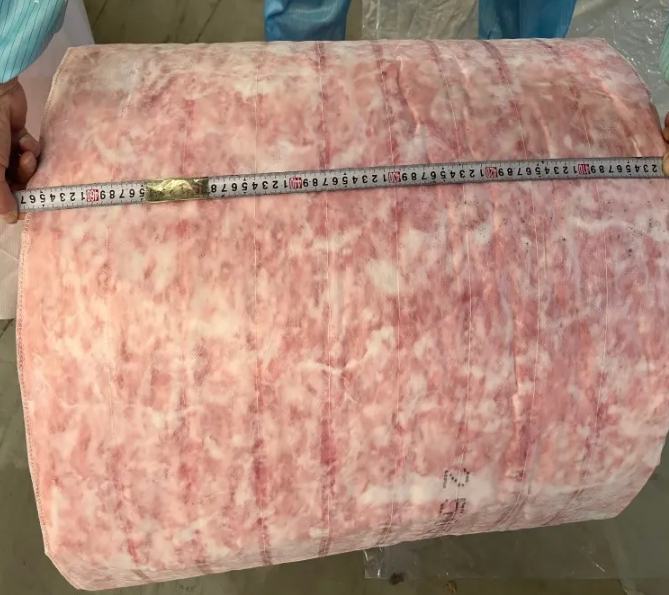Aug . 22, 2025 10:56
The manufacturing process of fiberglass filter media is a precision-driven sequence of steps that transforms raw glass materials into high-performance filtration products. These media, including Glasfaserfiltermedium, fiberglass filter roll, and Fiberglas-Filtermedienrollen, are valued for their ability to capture fine particles, resist high temperatures, and maintain efficiency in demanding environments. Hebei Fangyu Filter Material Technology Co.,Ltd. excels in this process, particularly with their Fiberglass Pocket Filter Media—constructed from ultra-fine fiberglass fiber media laminated with a pre-filter layer of nonwoven synthetic, and sewn with multiple rows of expanded stitching. This media serves medium to high efficiency needs in commercial, industrial, and specialty applications like oil mist and fume collection. Understanding each stage of manufacturing reveals how these media achieve their exceptional filtration capabilities.

Raw Material Preparation for Fiberglass Filter Media ----H2
- Glass Selection and Melting: The process begins with selecting high-purity glass, often a blend of silica and other oxides, which is melted at extremely high temperatures to form a molten glass mass. This molten glass is carefully controlled to ensure uniformity, as impurities can weaken the final Glasfaserfiltermedium. Hebei Fangyu Filter Material Technology Co.,Ltd. sources premium glass materials, ensuring the molten glass meets strict purity standards for consistent fiber quality.
- Fiber Formation: Molten glass is extruded through tiny nozzles, forming thin fibers that are rapidly cooled to solidify. This process, known as attenuation, creates the ultra-fine fibers that are the foundation of Glasfaserfiltermedium. The fiber diameter is precisely controlled—finer fibers enhance particle capture, while coarser fibers provide structural support. Hebei Fangyu Filter Material Technology Co.,Ltd. adjusts fiber diameter in their Glasfaserfiltermediumto match desired efficiency levels.
- Binder Application: To hold the fibers together, a binder (often a resin) is applied to the newly formed fibers. This binder ensures the Glasfaserfiltermediumretains its shape and integrity during handling and use. Hebei Fangyu Filter Material Technology Co.,Ltd. uses heat-resistant binders, allowing their Glasfaserfiltermedium to withstand high temperatures without degradation.
Lamination and Layering in Fiberglass Filter Roll ----H2
- Pre-Filter Integration: For enhanced performance, fiberglass filter rolloften includes a pre-filter layer of nonwoven synthetic material, which is laminated to the fiberglass core. This pre-filter captures larger particles, extending the life of the finer fiberglass layer. Hebei Fangyu Filter Material Technology Co.,Ltd.’s lamination process ensures strong adhesion between layers in their fiberglass filter roll, preventing delamination during use.
- Activated Carbon Addition: In some fiberglass filter rollproducts, a layer of activated carbon is laminated to the fiberglass media, enabling the capture of gases, odors, and volatile organic compounds (VOCs). This combination expands the media’s functionality beyond particle filtration. Hebei Fangyu Filter Material Technology Co.,Ltd. specializes in such hybrid fiberglass filter roll options, tailored for applications with both particulate and gaseous contaminants.
- Thickness Control: The lamination process allows for precise control over the thickness of fiberglass filter roll, which directly impacts filtration efficiency and airflow resistance. Thicker media offers higher dust holding capacity, while thinner media reduces pressure drop. Hebei Fangyu Filter Material Technology Co.,Ltd. adjusts thickness in their fiberglass filter rollto balance these factors for specific applications.
Forming and Cutting of Fiberglass Filter Media Rolls ----H2
- Web Formation: After lamination, the combined layers are formed into a continuous web, which is then wound onto rolls to create Fiberglas-Filtermedienrollen. This web is inspected for uniformity—any gaps or inconsistencies are addressed to ensure consistent filtration performance. Hebei Fangyu Filter Material Technology Co.,Ltd. uses automated web formation systems for their Fiberglas-Filtermedienrollen, minimizing defects and ensuring even fiber distribution.
- Cutting to Size: Fiberglass filter media rollsare cut into custom sizes based on customer needs, with common dimensions including 680mm, 695mm, or larger sizes up to 1400mm. Precision cutting ensures the media fits perfectly into filter housings or pocket filters. Hebei Fangyu Filter Material Technology Co.,Ltd. offers both standard and customized cutting for their Fiberglas-Filtermedienrollen, accommodating diverse application requirements.
- Quality Testing: Each fiberglass filter media rollundergoes rigorous testing, including efficiency checks (per EN 779:2012 and ISO 16890:2016 standards) and strength assessments. This ensures the media meets MERV 8, 11, 13, or 15 ratings as specified. Hebei Fangyu Filter Material Technology Co.,Ltd. maintains detailed test records for their Fiberglas-Filtermedienrollen, providing customers with verification of performance.
Specialized Processing for Fiberglass Pocket Filter Media ----H2
|
Typ
|
Temperature Resistance
|
Test Standards
|
MERV Rating
|
Size Options
|
Advantages
|
|
Traditional fiberglass fiber media
|
180℃
|
EN 779:2012
|
8-15
|
680, 695, customized (max 1400)
|
High Dust holding capacity
|
|
Pre-Filter layer laminated media
|
80℃
|
ISO 16890:2016
|
8-15
|
680, 695, customized (max 1400)
|
Longer life
|
|
Mit Glasfasermedien laminierte Aktivkohle
|
80℃
|
EN 779:2012, ISO 16890:2016
|
8-15
|
680, 695, customized (max 1400)
|
Best efficiency
|
- Stitching and Assembly: For pocket filters, the Glasfaserfiltermediumis cut into panels and sewn with multiple rows of expanded stitching, creating pockets that increase the filtration surface area. This stitching is done with heat-resistant threads to ensure durability. Hebei Fangyu Filter Material Technology Co.,Ltd.’s precise stitching process for their Fiberglass Pocket Filter Media enhances dust loading capacity and structural stability.
- Temperature Adaptation: The table above highlights the temperature resistance of different media types. Traditional media handles 180℃, making it suitable for high-heat applications, while pre-filter laminated and activated carbon-laminated media work at 80℃, ideal for moderate environments. Hebei Fangyu Filter Material Technology Co.,Ltd. ensures each type meets its temperature rating through rigorous testing.
- Efficiency Calibration: Each batch of specialized Glasfaserfiltermediumis tested to confirm MERV 8-15 ratings, aligning with EN 779:2012 and ISO 16890:2016 standards. This calibration guarantees the media performs as expected in capturing contaminants like oil mist and heavy airborne particles. Hebei Fangyu Filter Material Technology Co.,Ltd. prioritizes compliance with these standards in their manufacturing process.
Fiberglass Filter Media FAQS ----H2
What makes fiberglass filter media suitable for high-temperature applications? ----H3
Fiberglass filter media resists high temperatures due to its glass composition, which can withstand up to 180℃ in traditional forms. Hebei Fangyu Filter Material Technology Co.,Ltd.’s Glasfaserfiltermedium retains its structure and efficiency even in elevated heat, making it ideal for industrial ovens and high-temperature ventilation.
How does a fiberglass filter roll differ from other filter rolls? ----H3
Fiberglass filter roll stands out for its ultra-fine fibers that capture fine particles, high temperature resistance, and compatibility with pre-filter or activated carbon layers. Hebei Fangyu Filter Material Technology Co.,Ltd.’s fiberglass filter roll offers superior efficiency and durability compared to synthetic-only rolls in demanding environments.
Can fiberglass filter media rolls be customized for specific sizes? ----H3
Yes, Fiberglas-Filtermedienrollen from Hebei Fangyu Filter Material Technology Co.,Ltd. can be customized to sizes up to 1400mm, in addition to standard 680mm and 695mm options. This flexibility ensures a perfect fit for various filter housings and applications.
What is the lifespan of fiberglass filter media in industrial settings? ----H3
The lifespan of Glasfaserfiltermedium depends on dust load and application, but its high dust holding capacity extends service life. In industrial settings, Hebei Fangyu Filter Material Technology Co.,Ltd.’s Glasfaserfiltermedium typically lasts longer than synthetic media, reducing replacement frequency.
How does fiberglass filter media with activated carbon enhance filtration? ----H3
Fiberglass filter media laminated with activated carbon combines particle capture with gas and odor removal, making it effective for environments with both particulate and gaseous contaminants. Hebei Fangyu Filter Material Technology Co.,Ltd.’s version is ideal for fume collection and areas with chemical odors.

